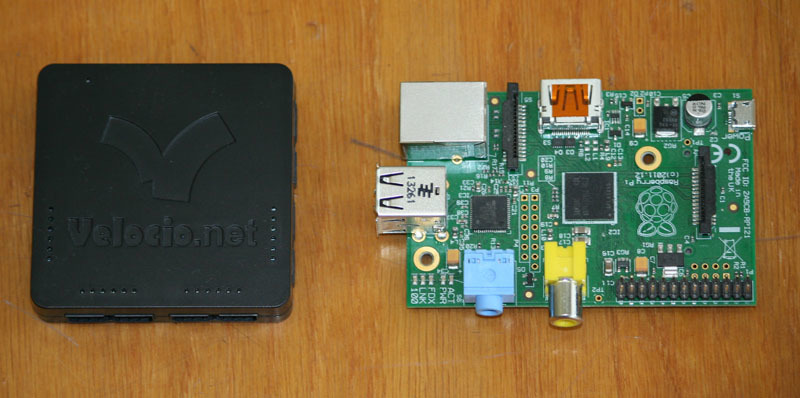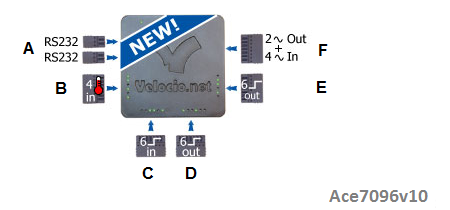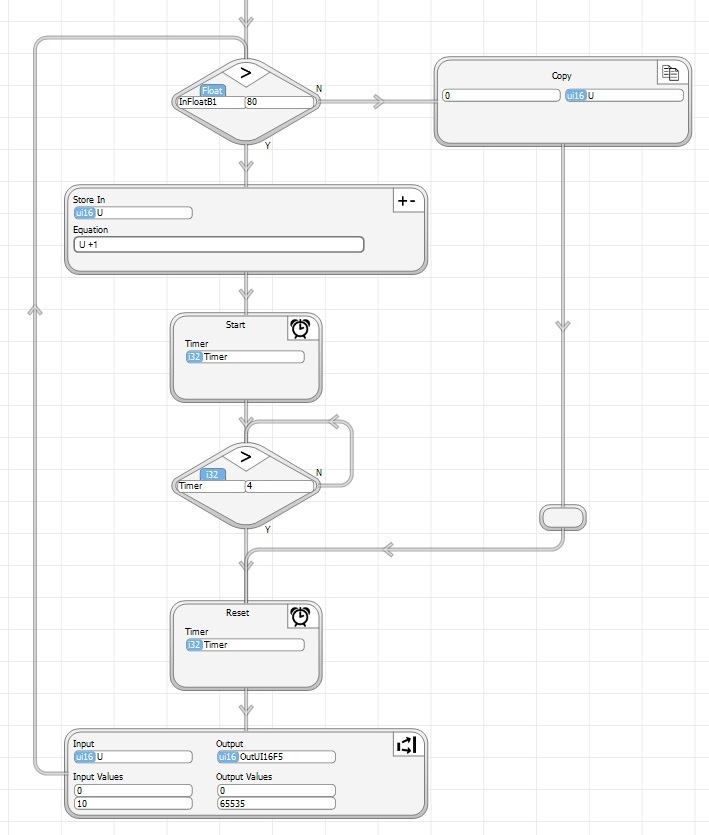Ace7096v10: the smallest PLC in the world
I already wrote about industrial programmable Ace controllers from Velocio on the example of the Ace3090v5 model. This time I want to tell you about the new model Ace7096v10:

For one increase in the status of Ace from the “small PLC” to “the smallest PLC in the world” - in the time that has passed since the previous publication, I could not find a more compact industrial controller. All Velocio PLCs of the Ace series, regardless of the number of inputs, outputs and communication ports, are of the same size 2.5 '' * 2.5 ''.
')
Here is for comparison:

With such small sizes, the Ace7096v10 has 28 digital and analog I / O and 3 communication ports.
All specifications of Ace7096v10:
Given the small size of Ace, you may be tempted to compare it with some microcomputers, such as the Raspberry PI:

But you need to understand that Raspberry and the like are not industrial PLCs and cannot replace PLCs in their original form without binding and convenient software. Comparison with Arduino is also incorrect. Although of course an automator with arduino in one hand, a bundle of wires in the second and a kettle of radio parts in the third can assemble any process control system without any PLC.
Since all Ace controllers have the same case, the models can only be distinguished by the label on the back of the case.
All connections to the PLC are made through the sockets on the sides:


Compared to the Ace 3060v5, 2 analog outputs and a second RS-232 have been added to the model 7096v10.
Analog outputs have ranges of 0 ... + 5V and 0 ... + 10V, they are designed to control devices that have analog inputs.
For example, a three-phase motor through a frequency converter:
Ace7096v10 can control not only asynchronous motors through an analog output, but also stepper motors by means of PWM modulation.
In the video, I connected the PLC to the laptop using the Modbus RTU protocol and output the information via SCADA SimpLight Free. Due to the presence of Modbas in the controller, it can be connected to any modern SCADA. For Ace, there is also its own free SCADA vFactory , but it is designed more for beginners and has a minimum of capabilities with one main advantage; with its help, even a person who does not know the meaning of the word “SCADA” can display the computer monitor information from the PLC.
Simultaneously with the connection to the computer, you can connect the controller to the touch panel - there are two pieces of the Ace7096v10 RS-232 ports.
As for programming, as with all Velocio PLCs, it is produced in the free vBuilder development environment in LD and Flow Chart. With LD, everything is clear , and Flow Chart is the language of flowcharts, which we all remember well from school lessons in computer science:

Here is a fragment of the motor control program through a 16-bit analog output 0..10 V. Everything is clear without reading the programming manual, right?
The only inconvenience is the absence of the PLC emulation mode in vBuilder; you cannot debug the program without a controller at hand.
Due to its small size, high density of inputs and outputs per unit area, 5-volt power and low power consumption, the Flow Chart programming language and other features, the 7096v10 controller is out of the usual PLC stereotype. In general, all the Velocio controllers look somewhat avant-garde. Nevertheless, the capabilities of the Ace7096v10 PLC are large and allow it to be used in home automation and in production for solving complex problems. More details about the Ace series of controllers can be found at the links:
All Ace models on the manufacturer's website (eng.)
Article about Ace3090v5 on Habré
Ace3090v5, iron
Ace3090v5 programming

For one increase in the status of Ace from the “small PLC” to “the smallest PLC in the world” - in the time that has passed since the previous publication, I could not find a more compact industrial controller. All Velocio PLCs of the Ace series, regardless of the number of inputs, outputs and communication ports, are of the same size 2.5 '' * 2.5 ''.
')
Here is for comparison:

With such small sizes, the Ace7096v10 has 28 digital and analog I / O and 3 communication ports.
All specifications of Ace7096v10:
| Title | Velocio Ace7096v10 | |
| Purpose | PLC for home and industrial automation | |
| DI | 6 | |
| Do | 12, transistor | |
| AI | Total | eight |
| Of these, AI 16 bits | 4 (Thermocouples J, K, T, N; ± 0.256 V, ± 0.512 V, ± 1.024 V, ± 2.048 V) | |
| Of these, AI 12 bits | 4 (0 ... + 5 V) | |
| AO | 2 (0 ... + 5 V, 0 ... + 10v), 16 bits | |
| Communication ports | 3 (2xRS-232, 1xUSB) | |
| Data transfer protocols | Modbus RTU slave, custom | |
| Data transfer rate, bps | 9600, 19200, 38400, 57600 | |
| Mount | DIN rail | |
| Nutrition | 5 V DC | |
| Dimensions | 63.5x63.5x12.7 mm | |
| Operating temperature | -40 ... 85 ° | |
| IP rating | IP65 | |
| Programming environment | Velocio vBuilder, free | |
| Programming languages | LD Flow Chart | |
| Price | $ 269 | |
Given the small size of Ace, you may be tempted to compare it with some microcomputers, such as the Raspberry PI:

But you need to understand that Raspberry and the like are not industrial PLCs and cannot replace PLCs in their original form without binding and convenient software. Comparison with Arduino is also incorrect. Although of course an automator with arduino in one hand, a bundle of wires in the second and a kettle of radio parts in the third can assemble any process control system without any PLC.
Since all Ace controllers have the same case, the models can only be distinguished by the label on the back of the case.
All connections to the PLC are made through the sockets on the sides:


Compared to the Ace 3060v5, 2 analog outputs and a second RS-232 have been added to the model 7096v10.
Analog outputs have ranges of 0 ... + 5V and 0 ... + 10V, they are designed to control devices that have analog inputs.
For example, a three-phase motor through a frequency converter:
Ace7096v10 can control not only asynchronous motors through an analog output, but also stepper motors by means of PWM modulation.
In the video, I connected the PLC to the laptop using the Modbus RTU protocol and output the information via SCADA SimpLight Free. Due to the presence of Modbas in the controller, it can be connected to any modern SCADA. For Ace, there is also its own free SCADA vFactory , but it is designed more for beginners and has a minimum of capabilities with one main advantage; with its help, even a person who does not know the meaning of the word “SCADA” can display the computer monitor information from the PLC.
Simultaneously with the connection to the computer, you can connect the controller to the touch panel - there are two pieces of the Ace7096v10 RS-232 ports.
As for programming, as with all Velocio PLCs, it is produced in the free vBuilder development environment in LD and Flow Chart. With LD, everything is clear , and Flow Chart is the language of flowcharts, which we all remember well from school lessons in computer science:

Here is a fragment of the motor control program through a 16-bit analog output 0..10 V. Everything is clear without reading the programming manual, right?
The only inconvenience is the absence of the PLC emulation mode in vBuilder; you cannot debug the program without a controller at hand.
Due to its small size, high density of inputs and outputs per unit area, 5-volt power and low power consumption, the Flow Chart programming language and other features, the 7096v10 controller is out of the usual PLC stereotype. In general, all the Velocio controllers look somewhat avant-garde. Nevertheless, the capabilities of the Ace7096v10 PLC are large and allow it to be used in home automation and in production for solving complex problems. More details about the Ace series of controllers can be found at the links:
All Ace models on the manufacturer's website (eng.)
Article about Ace3090v5 on Habré
Ace3090v5, iron
Ace3090v5 programming
Source: https://habr.com/ru/post/278663/
All Articles